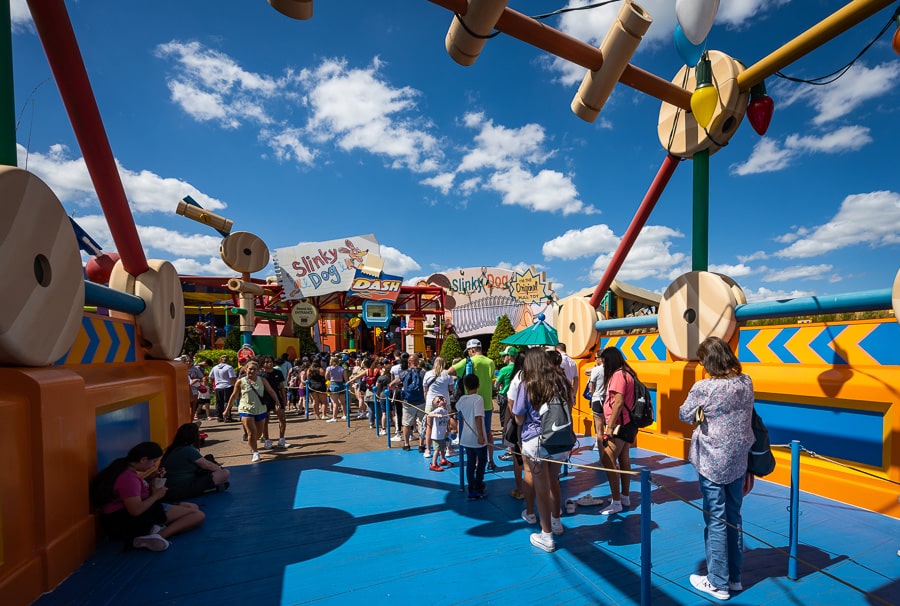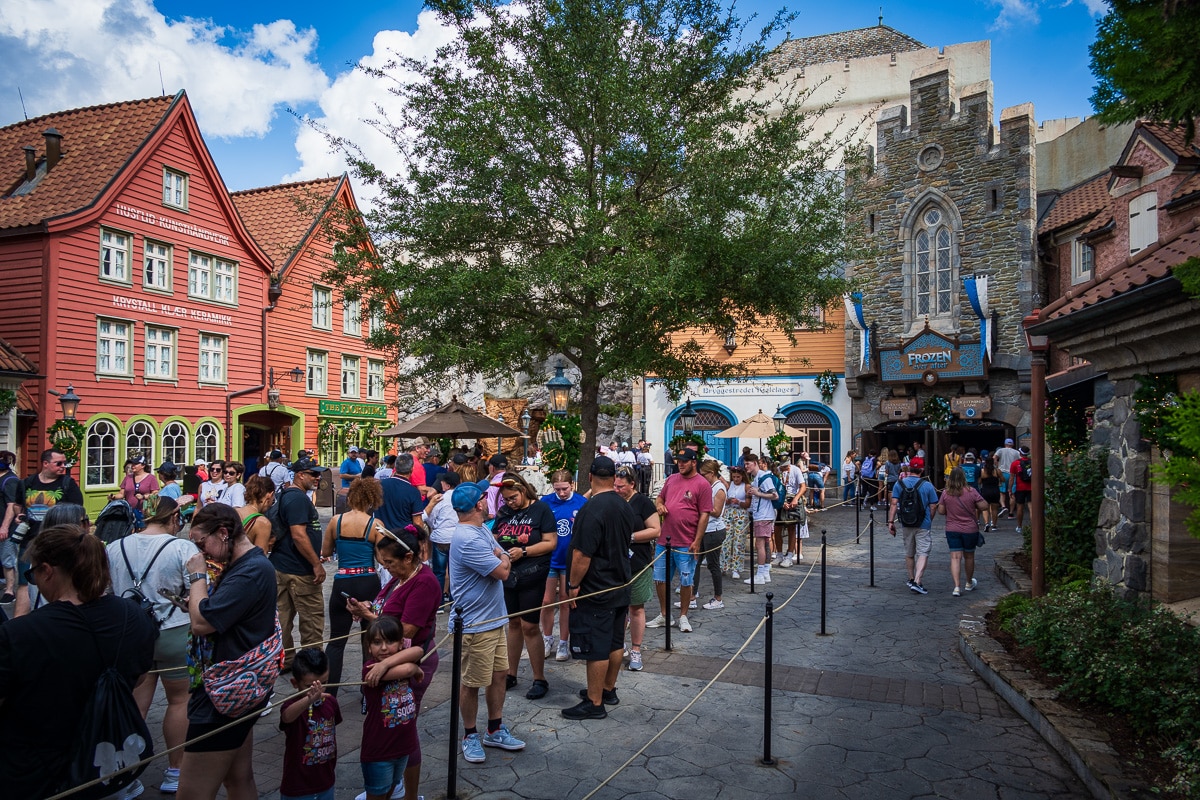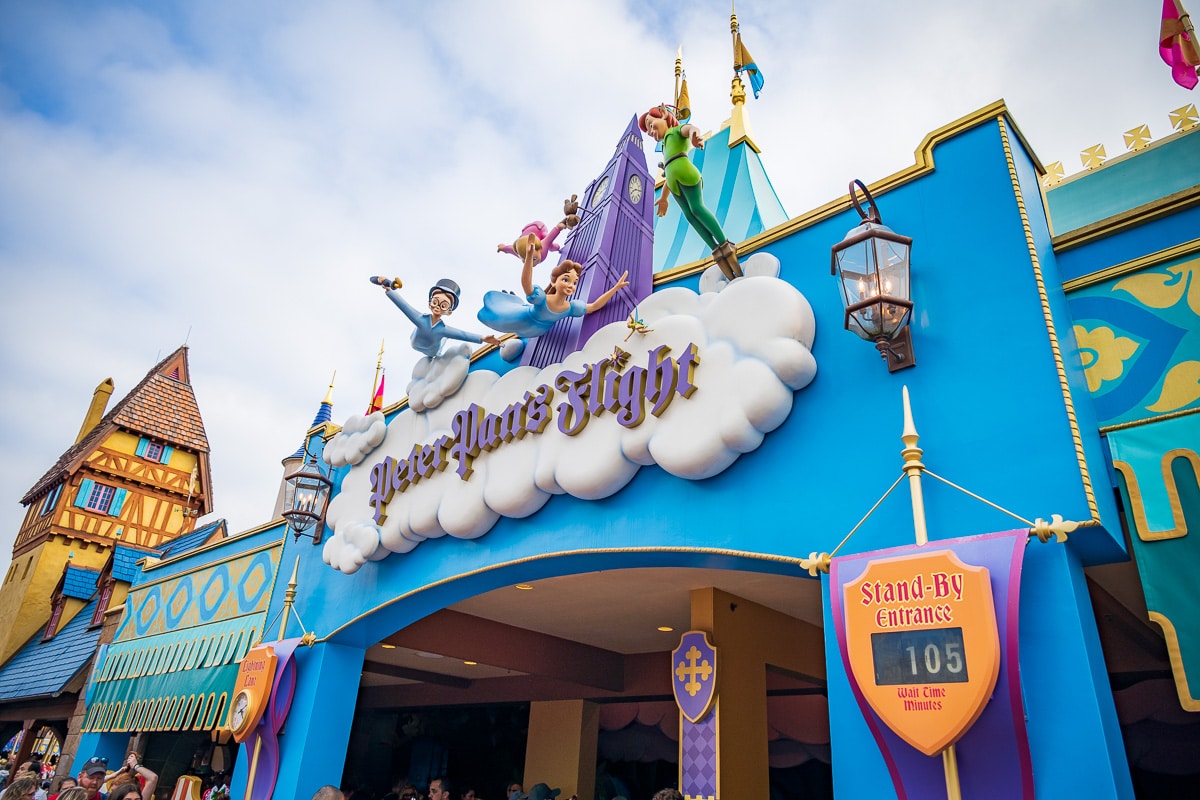
A proposed class action lawsuit has been filed against Walt Disney Parks & Resorts and Inspire Health Alliance for changes made to the Disability Access Service system last year at Walt Disney World and Disneyland. This covers details of the DAS complaint, plus an extensive look at past precedent in the last legal challenge to line-skipping accommodations in the parks.
Disney overhauled DAS at Walt Disney World and Disneyland prior to the start of last summer. According to the company, the changes were due in large part to abuse, misuse, and proliferation of the program’s use–with issuances of DAS tripling from 2019 to last year. For more about the specifics of the new-look Disability Access Service, plus our commentary about winners & losers, collateral damage and more, see Disability Access Service (DAS) Changes at Walt Disney World FAQ.
We’ve been following this controversy closely for the last several months, receiving reports from readers and reading accounts of other guests applying for accommodations after the overhaul of DAS at Walt Disney World and Disneyland. Obviously, it’s a highly sensitive subject that is very, very personal since it is, quite literally, make or break for some guests trying to experience the parks. There have been widespread reports of guests who previously had DAS being denied and advised to use alternative accommodations, some of which are new–or are revised and highlighted more prominently.
Suffice to say, it’s been a contentious ~9 months between the company and the disabled community. Many fans have hoped that Walt Disney World and Disneyland would relax the policy or overhaul it once again, and there’s been a grassroots campaign to accomplish exactly that.
There have been a couple of recent tweaks to the program, the most notable of which is DAS verbiage removing “only” from the eligibility criteria. As we previously pointed out, that likely involved involvement from an army of attorneys, and even then, its motivations and outcomes are open to interpretation and debate. Our view is that it’s fairly consequential in the quantity of DAS issued despite being only a single word.
We thought we’d never know for sure what prompted the “only” change or what result it’ll have on the ratio of approvals to denials, but as it turns out, this lawsuit may be the answer. The complaint relies heavily on the presence of only, and a demand letter from last December that preceded the lawsuit.


The proposed class action suit Malone vs. Walt Disney Parks & Resorts, Inspire Health Alliance, et al., was filed in the Superior Court of Orange County, California on February 10, 2025. You can read the complaint for yourself here.
Plaintiff Trisha Malone alleges that she applied for DAS based on a physical disability. Her DAS accommodation was denied on the grounds that she did not meet Disney’s newly imposed eligibility criteria, which now restricts DAS accommodations to guests who, due to a developmental disability such as autism or a similar condition, are unable to wait in a conventional queue for an extended period.
The plaintiff alleges that new eligibility criteria imposed by Disney screens out individuals with physical disabilities, thus denying them the accommodation required to enjoy full access to Defendant’s facilities. Malone also alleges that Disney’s alternative accommodations—such as Attraction Queue Re-Entry, Meet-Up, Rider Switch, or Location Return Times—fail to provide equitable access and imposed undue burdens, logistical challenges, emotional distress, and safety risks.


Malone contents that the new DAS policies and practices systematically discriminate individuals with physical disabilities in violation of the Americans with Disabilities Act (ADA) and the California Unruh Civil Rights Act.
The new DAS violates her rights to equal access, privacy, and dignity under those acts and also infringes upon Health Insurance Portability and Accountability Act (HIPAA) guidelines, state privacy rights under the California Confidentiality of Medical Information Act (CMIA), and contains deceptive terms and conditions that contravenes the Consumer Legal Remedies Act (CLRA), as well as California Business and Professions Code § 17200.
There are seven causes of action in total, all of which are California state law claims. (California’s Unruh Civil Rights Act incorporates the Americans with Disabilities Act by reference, which is how that’s looped into the lawsuit.)


From our perspective, the crux of this case is in whether the new-look DAS imposed eligibility criteria that “screen out or tend to screen out an individual with a disability or any class of individuals with disabilities from fully and equally enjoying any goods, services, facilities, privileges, advantages, or accommodations, unless such criteria can be shown to be necessary.”
(I mentioned this before in analysis of the “only” change: By limiting the accommodation to only guests with developmental disabilities, it’s possible Disney is pre-screening out a class of disabled individuals that might run afoul of the ADA. If so, that’s still true with a straightforward reading of the statement of intent, since “only” simply reinforces the “due to” (just like previous iterations included “small percentage” of guests language).)
The core legal question is whether, by limiting DAS accommodations to guests with developmental disabilities who are “unable to wait in a conventional queue for an extended period of time,” Disney is unlawfully screening out individuals with physical or non-developmental disabilities.
Can Disney demonstrate that limiting DAS accommodations to only those individuals with developmental disabilities is necessary for the provision of its services? Basically, that should boil down to whether the pre-screening lawful in light of the alternative accommodations offered?
There’s obviously a lot more to the complaint than that, but we’re primarily concerned with the ADA. That’s what will be outcome-determinative for the future of DAS. The California claims are important for this particular plaintiff (and keeping the case in state court), but this is eventually going to be decided in federal court.


In life and law, the best predictor of future outcomes is past precedent. To that point, there’s the case of A.L. v. Walt Disney Parks and Resorts US, Inc. from a few years ago that was filed in response to the change from the Guest Assistance Card (“GAC”) to DAS. In that, the Eleventh Circuit Court of Appeals addressed whether Disney’s accommodations for guests with disabilities complied with the Americans with Disabilities Act (ADA).
You can read the full appellate decision here, but I’m going to go through some of the key facts, legal issues, and the court’s findings below. As you read, I think you’ll spot a number of parallels between the past and current controversies and cases.
In that case, A.L. is an adult male diagnosed with autism who visits Walt Disney World with his mother. A.L. is in his late twenties, but his developmental age is 5 to 7 years old. Due to his condition, A.L. has extremely limited communication skills and requires a structured routine, disruption of which leads to meltdowns.
Until October 2013, the GAC system provided a disabled guest and his group with unlimited, repeated, and on-demand access to rides and attractions. A.L. used this to experience, in order, a list of 19 attractions he enjoyed at Magic Kingdom. However, Disney determined that the GAC system was unsustainable due widespread abuse and fraud. It became an unlimited front-of-the-line pass for anyone requesting it because Disney could not ask a visitor for proof of disability. The GAC system became a media sensation for all of the wrong reasons, with mainstream stories about guests hiring disabled tour guides. (Sound familiar?)


During that case, Disney’s Industrial Engineering team presented the results of its studies on attraction impact resulting from GAC, which was significant. The study concluded that the GAC system was unintentionally providing a small minority of visitors multiple opportunities to experience a given ride while denying regular guests the chance to experience a given ride even once. This study prompted Disney to implement changes to the GAC system in the interest of balancing guests’ needs.
In October 2013, Disney replaced the GAC system with the DAS program. You’re probably familiar with this, as the mechanics of DAS are fairly unchanged then versus now (it’s the approvals and denials that are at issue here). Basically, A.L.’s family determined that the return time system used by DAS required too long of a wait for A.L., and since it would not be possible to visit all of A.L.’s regular rides in order without some waiting, and that they would need to leave the park.
The DAS program proved to be unpopular among some of Disney’s fans with disabilities. By early 2014, plaintiffs began filing lawsuits—forty-four in total—challenging the DAS program on the basis that it violated Title III of the ADA because it did not allow visitors with disabilities to go on rides without waiting and in the order they wanted. The plaintiffs filed their cases in either the Central District of California or the Middle District of Florida; the cases filed in California eventually were transferred to the Middle District of Florida.
A.L. sought a permanent injunction requiring that he be permitted unlimited access to Walt Disney World’s attractions via the FastPass lines or similar relief through at least ten Re-admission Passes (“Re-Ads”). The central question of the consolidated case was whether Disney’s existing disability accommodations were sufficient under the ADA or if the requested modifications were necessary and reasonable.


The district court found that A.L.’s requested modification of unlimited access to Disney’s theme park attractions—via Disney’s expedited FastPass lines or through at least ten readmission passes for each person in his party—was neither necessary nor a reasonable accommodation. As to whether the proposed modification was necessary, the district court found that access for A.L. using the DAS Card and FastPass, without further modification, was a “like experience” to that of non-disabled guests.
The district court explained that, because the DAS system allowed disabled guests to access the most popular attractions in the park with less wait time than the standby line, those guests could experience more attractions than a non-DAS guest could experience because some of their time spent waiting in physical lines throughout the day had been eliminated.
The district court noted that Disney’s evidence showed A.L. could have experienced “a significantly higher number of rides than a typical nondisabled guest experiences in a day.” Thus, the district court found that the DAS card provided A.L. with a “‘like,’ if not better, experience and equal enjoyment than nondisabled guests experience.”


As to reasonableness, the district court explained the accommodation would “lengthen the wait times for all other riders, severely impacting the remaining non-DAS users,” and “potentially lead to the same fraud and overuse that existed with the GAC system, which required a complete overhaul.”
The district court also noted that “word spreading on social media that one disabled individual received an accommodation of ten readmission passes will increase the demand to be treated similarly by every disabled individual once they find out, as well as those willing to misrepresent they are disabled,” leading to the same issues plaguing the GAC system.
Even if the requested modification were necessary and reasonable, the district court determined that Disney was not required to accommodate A.L. with the request because, based on Disney’s uncontroverted industrial engineering studies and its expert’s opinion, it would fundamentally alter Disney’s services to its other visitors, by increasing wait times for most other guests without DAS, which in turn would dramatically reduce guest satisfaction levels.


In assessing whether A.L.’s requested modification to the DAS program was necessary under Title III of the ADA, the court held that Disney must afford A.L. “the opportunity to have something akin to or similar to the experience” of non-disabled guests but Disney “was not required to make the preferred accommodation of A.L.’s choice.”
Because places of public accommodations must “provide disabled patrons an experience comparable to that of able-bodied patrons,” whether an accommodation sought by a disabled person is “necessary” as a matter of law is determined by considering first “how [the business’s] facilities are used by nondisabled guests.”
The analysis then turns to whether the business has taken reasonable steps to provide disabled guests with a ‘like experience’ to that of non-disabled guests. “[F]acilities are not required to make the preferred accommodation of plaintiffs’ choice. Facilities need make only reasonable accommodations that are ‘necessary.’” As a matter of law, it is not enough to show that the accommodation Disney offers does not eliminate all discomfort or difficulty.
Due to the legal issues raised in this case that are distinct from A.L., I suspect the above reasoning will be key to the ultimate outcome of this case.


The Eleventh Circuit affirmed the district court’s judgment in A.L., agreeing that the requested modifications were not necessary and would fundamentally alter Disney’s operations. The court emphasized that the ADA does not require businesses to make accommodations that would fundamentally change their services or operations.
It’s worth noting that the Eleventh Circuit cited several other ADA cases involving Disney Parks & Resorts in its decision. I checked each of these decisions and they were likewise decided in Disney’s favor with similar reasoning. (Which tracks, as a court typically would cite precedent that support its conclusions.) Perhaps further research would reveal decisions where the plaintiff prevailed, but I could find no such cases. There’s a first time for everything, but I do not believe the Malone case will be that time. It will be an uphill battle for the plaintiff here, or in any future cases challenging the new-look DAS, to prevail.
Nevertheless, it’ll be interesting to see what happens. As we’ve mentioned previously, it was inevitable for the DAS changes to end up in court. Disney likely viewed a lawsuit as the cost of doing business, and had its legal team meticulously prepare the new DAS policies in a manner that would make them litigation-proof. There were 24 lawsuits last time, with the first filed only a few months after GAC was retired in favor of DAS. If anything, it’s surprising there haven’t been more complaints filed this go-round, and sooner. It’ll be an interesting saga to watch, and if this does proceed to trial, it’s likely that more will be revealed about abuse and misuse numbers either via discovery or testimony of Disney’s Industrial Engineers.
Planning a Walt Disney World trip? Learn about hotels on our Walt Disney World Hotels Reviews page. For where to eat, read our Walt Disney World Restaurant Reviews. To save money on tickets or determine which type to buy, read our Tips for Saving Money on Walt Disney World Tickets post. Our What to Pack for Disney Trips post takes a unique look at clever items to take. For what to do and when to do it, our Walt Disney World Ride Guides will help. For comprehensive advice, the best place to start is our Walt Disney World Trip Planning Guide for everything you need to know!
YOUR THOUGHTS
Thoughts on the lawsuit in California over DAS policies at Walt Disney World and Disneyland? Think this litigation will result in changes or another total overhaul to Disability Access Services? Hopeful that this will prompt increased approvals for those who truly need DAS while keeping abuse low? Agree or disagree with our assessment? Please try to stay on topic–we’ve noticed some of these DAS comments sections get heated and personal. Discuss the policy itself, not others’ use (or lack thereof) of it.












